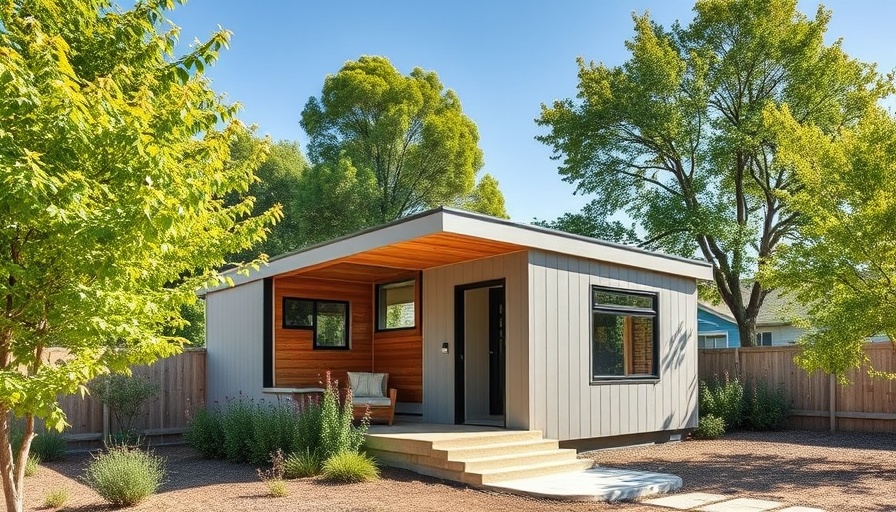
Understanding the Rise of ADUs in California
The concept of accessory dwelling units (ADUs) is rapidly gaining traction among homeowners in California, and for good reason. As the state faces an ongoing housing crisis, ADUs serve as a practical solution to provide affordable living options. With an estimated growth of 140% in the ADU market projected by 2032, the opportunity to build one can not only alleviate housing shortages but can also enhance your property’s value.
What Exactly Is an ADU?
ADUs are small, self-contained homes located on the same lot as a primary dwelling. Typically ranging from 500 to 600 square feet, they contain essential amenities such as kitchens, bathrooms, and living spaces. Commonly dubbed "granny pods" due to their use by families for aging relatives, ADUs can also function as a source of rental income, making them increasingly attractive to homeowners.
The Benefits of Building an ADU
Building an ADU comes with a multitude of advantages:
- Increased Space: ADUs provide extra room for family members, guests, or tenants without the need to relocate.
- Enhanced Property Value: Properties with ADUs often have higher market values, making them a smart investment.
- Flexible Living Arrangements: ADUs accommodate extended family, guests, or renters in a close-knit yet independent setup.
These benefits are particularly significant in urban and suburban California, where housing costs continue to rise sharply.
Costs and Considerations of Building an ADU
While the prospect of earning rental income sounds appealing, potential builders must keep several factors in mind:
- Upfront Costs: Depending on the type of ADU, costs can vary significantly, particularly for detached units requiring separate utilities.
- Property Taxes: Owners should be aware that adding an ADU may lead to higher property tax assessments.
- Maintenance Responsibilities: If you plan to rent out the ADU, it will require regular maintenance and occasional repairs.
Evaluating these factors can help determine if an ADU is a right fit for your property and financial situation.
Selecting the Right Type of ADU for Your Needs
ADUs come in various forms, each with unique benefits and drawbacks:
- Attached ADUs: These units are built onto the primary residence, sharing walls and some utilities. They are generally cheaper to construct compared to detached ADUs but may lead to higher heating and cooling bills.
- Detached ADUs: Often seen as tiny homes in the backyard, they ensure maximum privacy but require more investment.
- Garage Conversions: If you have an underused garage, consider converting it into an ADU. This is a more budget-friendly approach, utilizing existing structures.
- Basement ADUs: Transforming a basement into a self-sufficient unit is another option, though it may necessitate significant renovations.
- ADUs Above Garages: Offering a clever use of vertical space, these units can take advantage of an existing garage footprint.
Depending on your available space and budget, one of these options may be well-suited for your needs.
Regulatory Framework for ADUs in California
Before jumping into construction, homeowners must familiarize themselves with local zoning laws and building codes that govern ADUs. Regulations can differ significantly among municipalities, so it’s vital to consult your local government.
Some common factors to consider include setback requirements, occupancy permits, and height restrictions. Taking these into account ensures that your ADU is legally compliant and sets you on the path to successful construction.
Future Trends in the ADU Market
As the demand for affordable housing options continues to rise, ADUs are poised to become a permanent fixture in California’s real estate landscape. With the increasing acceptance of this housing model, we can expect supportive policies and incentives aimed at easing construction approvals.
Furthermore, advancements in modular construction techniques may lead to faster, more economical options for homeowners looking to enter the ADU market. With potential pathways such as state-funded grants available for ADU construction, the conversation about efficient housing solutions is more relevant than ever.
Conclusion: The Path to ADU Ownership
If you’re considering an ADU as an investment or an additional living space, there are numerous factors to weigh, from the potential increase in property value to the obligations involved in construction and maintenance. Start by assessing your space, unraveling the regulatory environment, and choosing the right type of unit that aligns with your goals. Building an ADU could be a significant step toward financial independence and improved familial arrangements, ensuring you’re part of California’s evolving housing narrative.
Call to Action: Interested in exploring your options for building an ADU? Consult a local contractor or housing expert to discuss potential plans and costs tailored for your property!
 Add Row
Add Row  Add
Add 




Write A Comment